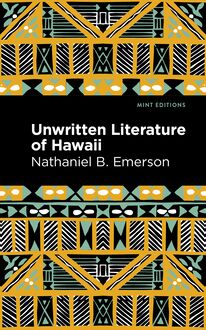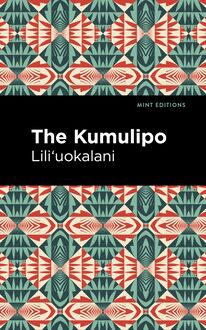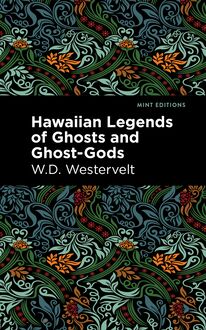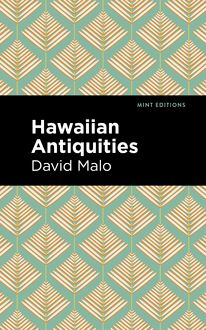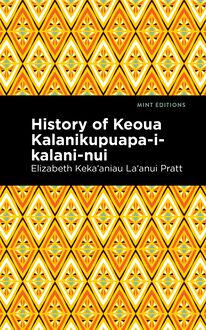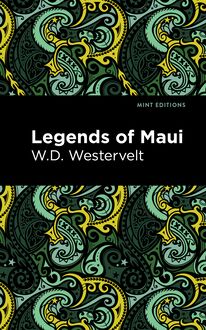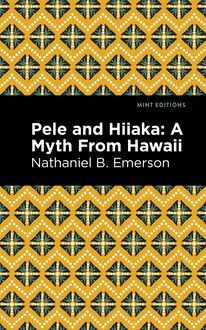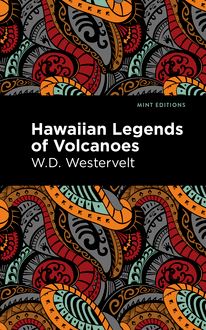-
 Univers
Univers
-
 Ebooks
Ebooks
-
 Livres audio
Livres audio
-
 Presse
Presse
-
 Podcasts
Podcasts
-
 BD
BD
-
 Documents
Documents
-
- Cours
- Révisions
- Ressources pédagogiques
- Sciences de l’éducation
- Manuels scolaires
- Langues
- Travaux de classe
- Annales de BEP
- Etudes supérieures
- Maternelle et primaire
- Fiches de lecture
- Orientation scolaire
- Méthodologie
- Corrigés de devoir
- Annales d’examens et concours
- Annales du bac
- Annales du brevet
- Rapports de stage
La lecture à portée de main
Vous pourrez modifier la taille du texte de cet ouvrage
Découvre YouScribe en t'inscrivant gratuitement
Je m'inscrisDécouvre YouScribe en t'inscrivant gratuitement
Je m'inscrisEn savoir plus
Vous pourrez modifier la taille du texte de cet ouvrage
En savoir plus

Description
Unwritten Literature of Hawaii: The Sacred Songs of the Hula (1909) is a collection of hulas and essays by Nathaniel B. Emerson. Translating previously unwritten songs, interviewing native Hawaiians, and consulting the works of indigenous historians, Emerson provides an entertaining and authoritative look at one of Hawaii’s most cherished traditions. “For an account of the first hula we may look to the story of Pele. On one occasion that goddess begged her sisters to dance and sing before her, but they all excused themselves, saying they did not know the art. At that moment in came little Hiiaka, the youngest and the favorite. […] When banteringly invited to dance, to the surprise of all, Hiiaka modestly complied. The wave-beaten sand-beach was her floor, the open air her hall; Feet and hands and swaying form kept time to her improvisation.” As an American born in Hawaii who played a major role in the annexation of the islands as an author of the 1887 Constitution of the Hawaiian Kingdom, Emerson likely saw himself as a unifying figure capable of interpreting for an English-speaking audience the ancient and sacred tradition of the hula, a Polynesian dance often accompanied with instruments and chanting or singing. Combining critical analysis with samples of popular hulas in both Hawaiian and English, Emerson works to preserve part of the rich cultural heritage of the Hawaiian Islands. With a beautifully designed cover and professionally typeset manuscript, this edition of Nathaniel B. Emerson’s Unwritten Literature of Hawaii: The Sacred Songs of the Hula is a classic of Hawaiian literature reimagined for modern readers.
Sujets
Informations
| Publié par | Mint Editions |
| Date de parution | 03 août 2021 |
| Nombre de lectures | 0 |
| EAN13 | 9781513297408 |
| Langue | English |
| Poids de l'ouvrage | 1 Mo |
Informations légales : prix de location à la page 0,0500€. Cette information est donnée uniquement à titre indicatif conformément à la législation en vigueur.
Extrait
Unwritten Literature of Hawaii
The Sacred Songs of the Hula
Nathaniel B. Emerson
Unwritten Literature of Hawaii: The Sacred Songs of the Hula was first published in 1909.
This edition published by Mint Editions 2021.
ISBN 9781513295909 | E-ISBN 9781513297408
Published by Mint Editions®
minteditionbooks.com
Publishing Director: Jennifer Newens
Design & Production: Rachel Lopez Metzger
Project Manager: Micaela Clark
Typesetting: Westchester Publishing Services
C ONTENTS I NTRODUCTION I. T HE HULA II. T HE HALAU ; THE KUAHU — THEIR DECORATION AND CONSECRATION III. T HE GODS OF THE HULA IV. S UPPORT AND ORGANIZATION OF THE HULA V. C EREMONIES OF GRADUATION ; DÉBUT OF A HULA DANCER VI. T HE PASSWORD — THE SONG OF ADMISSION VII. W ORSHIP AT THE ALTAR OF THE HALAU VIII. C OSTUME OF THE HULA DANCER IX. T HE HULA ALA ’ A - PAPA X. T HE HULA PA - ÍPU , OR KUÓLO XI. T HE HULA KI ’ I XII. T HE HULA PAHU XIII. T HE HULA ÚLI - ULÍ XIV. T HE HULA PUÍLI XV. T HE HULA KA - LAAU XVI. T HE HULA ÍLI - ÍLI XVII. T HE HULA KÁ - ÉKE - ÉKE XVIII. A N INTERMISSION XIX. T HE HULA NIAU - KANI XX. T HE HULA OHE XXI. T HE MUSIC AND MUSICAL INSTRUMENTS OF THE H AWAIIANS XXII. G ESTURE XXIII. T HE HULA PA - HUA XXIV. T HE HULA P ELE XXV. T HE HULA PA ’ I - UMAUMA XXVI. T HE HULA KU ’ I M OLOKAI XXVII. T HE HULA KIELÉI XXVIII. T HE HULA MÚ ’ U - MÚ ’ U XXIX. T HE HULA KOLANI XXX. T HE HULA KOLEA XXXI. T HE HULA MANÓ XXXII. T HE HULA ILÍO XXXIII. T HE HULA PUA ’ A XXXIV. T HE HULA OHELO XXXV. T HE HULA KILU XXXVI. T HE HULA HOO - NA - NÁ XXXVII. T HE HULA ULILI XXXVIII. T HE HULA O - NIU XXXIX. T HE HULA KU ’ I XL. T HE OLI XLI. T HE WATER OF K ANE XLII. G ENERAL REVIEW
I NTRODUCTION
This book is for the greater part a collection of Hawaiian songs and poetic pieces that have done service from time immemorial as the stock supply of the hula . The descriptive portions have been added, not because the poetical parts could not stand by themselves, but to furnish the proper setting and to answer the questions of those who want to know.
Now, the hula stood for very much to the ancient Hawaiian; it was to him in place of our concert-hall and lecture-room, our opera and theater, and thus became one of his chief means of social enjoyment. Besides this, it kept the communal imagination in living touch with the nation’s legendary past. The hula had songs proper to itself, but it found a mine of inexhaustible wealth in the epics and wonder-myths that celebrated the doings of the volcano goddess Pele and her compeers. Thus in the cantillations of the old-time hula we find a ready-made anthology that includes every species of composition in the whole range of Hawaiian poetry. This epic 1 of Pele was chiefly a more or less detached series of poems forming a story addressed not to the closet-reader, but to the eye and ear and heart of the assembled chiefs and people; and it was sung. The Hawaiian song, its note of joy par excellence, was the oli; but it must be noted that in every species of Hawaiian poetry, mele —whether epic or eulogy or prayer, sounding through them all we shall find the lyric note.
The most telling record of a people’s intimate life is the record which it unconsciously makes in its songs. This record which the Hawaiian people have left of themselves is full and specific. When, therefore, we ask what emotions stirred the heart of the old-time Hawaiian as he approached the great themes of life and death, of ambition and jealousy, of sexual passion, of romantic love, of conjugal love, and parental love, what his attitude toward nature and the dread forces of earthquake and storm, and the mysteries of spirit and the hereafter, we shall find our answer in the songs and prayers and recitations of the hula.
The hula, it is true, has been unfortunate in the mode and manner of its introduction to us moderns. An institution of divine, that is, religious, origin, the hula in modern times has wandered so far and fallen so low that foreign and critical esteem has come to associate it with the riotous and passionate ebullitions of Polynesian kings and the amorous posturing of their voluptuaries. We must make a just distinction, however, between the gestures and bodily contortions presented by the men and women, the actors in the hula, and their uttered words. “The voice is Jacob’s voice, but the hands are the hands of Esau.” In truth, the actors in the hula no longer suit the action to the word. The utterance harks back to the golden age; the gesture is trumped up by the passion of the hour, or dictated by the master of the hula, to whom the real meaning of the old bards is ofttimes a sealed casket.
Whatever indelicacy attaches in modern times to some of the gestures and contortions of the hula dancers, the old-time hula songs in large measure were untainted with grossness. If there ever were a Polynesian Arcadia, and if it were possible for true reports of the doings and sayings of the Polynesians to reach us from that happy land—reports of their joys and sorrows, their love-makings and their jealousies, their family spats and reconciliations, their worship of beauty and of the gods and goddesses who walked in the garden of beauty—we may say, I think, that such a report would be in substantial agreement with the report that is here offered; but, if one’s virtue will not endure the love-making of Arcadia, let him banish the myth from his imagination and hie to a convent or a nunnery.
If this book does nothing more than prove that savages are only children of a younger growth than ourselves, that what we find them to have been we ourselves—in our ancestors—once were, the labor of making it will have been not in vain.
For an account of the first hula we may look to the story of Pele. On one occasion that goddess begged her sisters to dance and sing before her, but they all excused themselves, saying they did not know the art. At that moment in came little Hiiaka, the youngest and the favorite. Unknown to her sisters, the little maiden had practised the dance under the tuition of her friend, the beautiful but ill-fated Hopoe. When banteringly invited to dance, to the surprise of all, Hiiaka modestly complied. The wave-beaten sand-beach was her floor, the open air her hall. Feet and hands and swaying form kept time to her improvisation:
Look, Puna is a-dance in the wind;
The palm groves of Kea-au shaken.
Haena and the woman Hopoe dance and sing
On the beach Nana-huki,
A dance of purest delight,
Down by the sea Nana-huki.
The nature of this work has made it necessary to use occasional Hawaiian words in the technical parts. At their first introduction it has seemed fitting that they should be distinguished by italics; but, once given the entr é e, it is assumed that, as a rule, they will be granted the rights of free speech without further explanation.
A glossary, which explains all the Hawaiian words used in the prose text, is appended. Let no one imagine, however, that by the use of this little crutch alone he will be enabled to walk or stumble through the foreign ways of the simplest Hawaiian mele . Notes, often copious, have been appended to many of the mele, designed to exhaust neither the subject nor the reader, but to answer some of the questions of the intelligent thinker.
Thanks, many thanks, are due, first, to those native Hawaiians who have so far broken with the old superstitious tradition of concealment as to unearth so much of the unwritten literary wealth stored in Hawaiian memories; second, to those who have kindly contributed criticism, suggestion, material at the different stages of this book’s progress; and, lastly, to those dear friends of the author’s youth—living or dead—whose kindness has made it possible to send out this fledgling to the world. The author feels under special obligations to Dr. Titus Munson Coan, of New York, for a painstaking revision of the manuscript.
H ONOLULU, H AWAII
1 . It might be termed a handful of lyrics strung on an epic thread.
I
T HE HULA
One turns from the study of old genealogies, myths, and traditions of the Hawaiians with a hungry despair at finding in them means so small for picturing the people themselves, their human interests and passions; but when it comes to the hula and the whole train of feelings and sentiments that made their entrances and exits in the halau (the hall of the hula) one perceives that in this he has found the door to the heart of the people. So intimate and of so simple confidence are the revelations the people make of themselves in their songs and prattlings that when one undertakes to report what he has heard and to translate into the terms of modern speech what he has received in confidence, as it were, he almost blushes, as if he had been guilty of spying on Adam and Eve in their nuptial bower. Alas, if one could but muffle his speech with the unconscious lisp of infancy, or veil and tone his picture to correspond to the perspective of antiquity, he might feel at least that, like Watteau, he had dealt worthily, if not truly, with that ideal age which we ever think of as the world’s garden period.
The Hawaiians, it is true, were many removes from being primitives; their dreams, however, harked back to a period that was close to the world’s infancy. Their remote ancestry was, perhaps, akin to ours—Aryan, at least Asiatic—but the orbit of their evolution seems to have led them away from the strenuous discipline that has whipped the Anglo-Saxon branch into fighting shape with fortune.
If one comes to the study of the hula and its songs in the spirit of a censorious moralist he will find nothing for him; if as a pure ethnologist, he will take pleasure in pointing out the physical resemblances of the Hawaiian dance to the languorous grace of the Nautch girls, of the geisha, and other oriental dancers. But if he comes as a student and lover of human nature, back of the sensuous posturings, in the emotional langua
-
 Univers
Univers
-
 Ebooks
Ebooks
-
 Livres audio
Livres audio
-
 Presse
Presse
-
 Podcasts
Podcasts
-
 BD
BD
-
 Documents
Documents
-
Jeunesse
-
Littérature
-
Ressources professionnelles
-
Santé et bien-être
-
Savoirs
-
Education
-
Loisirs et hobbies
-
Art, musique et cinéma
-
Actualité et débat de société
-
Jeunesse
-
Littérature
-
Ressources professionnelles
-
Santé et bien-être
-
Savoirs
-
Education
-
Loisirs et hobbies
-
Art, musique et cinéma
-
Actualité et débat de société
-
Actualités
-
Lifestyle
-
Presse jeunesse
-
Presse professionnelle
-
Pratique
-
Presse sportive
-
Presse internationale
-
Culture & Médias
-
Action et Aventures
-
Science-fiction et Fantasy
-
Société
-
Jeunesse
-
Littérature
-
Ressources professionnelles
-
Santé et bien-être
-
Savoirs
-
Education
-
Loisirs et hobbies
-
Art, musique et cinéma
-
Actualité et débat de société
- Cours
- Révisions
- Ressources pédagogiques
- Sciences de l’éducation
- Manuels scolaires
- Langues
- Travaux de classe
- Annales de BEP
- Etudes supérieures
- Maternelle et primaire
- Fiches de lecture
- Orientation scolaire
- Méthodologie
- Corrigés de devoir
- Annales d’examens et concours
- Annales du bac
- Annales du brevet
- Rapports de stage
